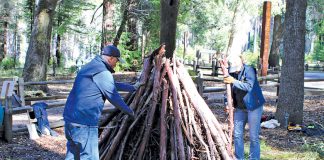With every rain forecast I hope for enough precipitation to give my garden a good soak. Last Monday I was not disappointed. I heard the pitter-patter of rain on leaves and jumped up in the morning to check the rain gauge. To my delight the last storm dropped 1.67 inches of the wet stuff on my garden in Bonny Doon. The prior three October showers had barely totaled a tenth of an inch. Last year, the hills and meadows were already greening up with three inches of the wet stuff. After this much needed precipitation, the deer are happy, the forest is happy, our gardens are happy, everybody is happy.
Some weather forecasters are predicting a drier than normal November for our area while a recent National Oceanic and Atmospheric Administration report predicted El Niño rains starting this November. I’m going with the folks at NOAA. A November 1st rain event qualifies them as the best forecasters so far.
I’m enjoying the vibrant colors of the fall garden. Everything is brighter after a rain. I’ll also be looking for some new plants with berries for the birds, more shrubs with fall and winter interest and a couple of new grasses. With water conservation in mind, here are some of the plants I’m considering. Some put on their best show at the end of the season.
I can’t get enough of delicious pineapple guava fruit thanks to my best friend, Karen. Her plant is loaded with fruit this year. Pineapple guava has been on my wish list for a while because of its versatility and this fall I’m going to plant one. Easy to grow Feijoa sellowiana needs only occasional watering. An established plant can survive without any supplemental water but if you want to enjoy more flowers and delicious fruit, give them a little extra water especially during flowering and fruiting periods. Mulch the soil around the plants to protect the shallow roots and conserve moisture.
The early summer flowers are showy, contrast nicely with the gray green foliage and are completely edible. You can eat them right off the plant, toss them into a salad, add them to iced tea or make jelly. They have a fruity flavor and bees, butterflies and birds also appreciate them. The pineapple-flavored two-inch oval fruit is produced three to four months after the flowers. It’s easy to cut the little fruits in half and scoop out the fleshy inside with a spoon.
Pineapple guava grows at a medium rate to about 10 to 15 feet tall and wide. You can easily train one as an espalier, hedge or small specimen tree. They do well in containers, too, so if you’re like a lot of people with limited space or time, this is a good plant to grow. Did I mention they’re deer-resistant? This is one unfussy plant.
Another plant that is definitely going to be planted in my landscape this fall is a California native. Each year when I see a toyon (Heteromeles arbutifolia) covered in red berries I vow to get one for myself. They have very low water needs even in the summer and make a good addition for the back of the garden. Irrigate them occasionally during spring and summer to promote fire resistance. Although they often take a few years to establish, their deep roots are good for soil erosion and slope stabilization.
Also known as the Christmas berry, no berry is more sought after when in season. Robins love them. Waxwings and purple finches also rip open the fruits to eat in great numbers. Unlike pyracantha berries, birds do not get drunk on toyon berries. Bees and butterflies are attracted to the flowers.
Toyon is one of the classic shrubs of the California chaparral. Except for an extension into Baja, the shrub only occurs in California. It resembles the European holly and its abundance in Southern California’s HollyCanyon inspired the name “Hollywood.” The name toyon was given by the Ohlone tribe and is the only California native plant that continues to be commonly known by a Native American name.
Toyon makes good container specimens and the berries can be used in place of English holly for Christmas decorating.
Jan Nelson, a landscape designer and California certified nursery professional, will answer questions about gardening in the Santa Cruz Mountains. E-mail her at ja******@*ol.com, or visit www.jannelsonlandscapedesign.com to view past columns and pictures.










